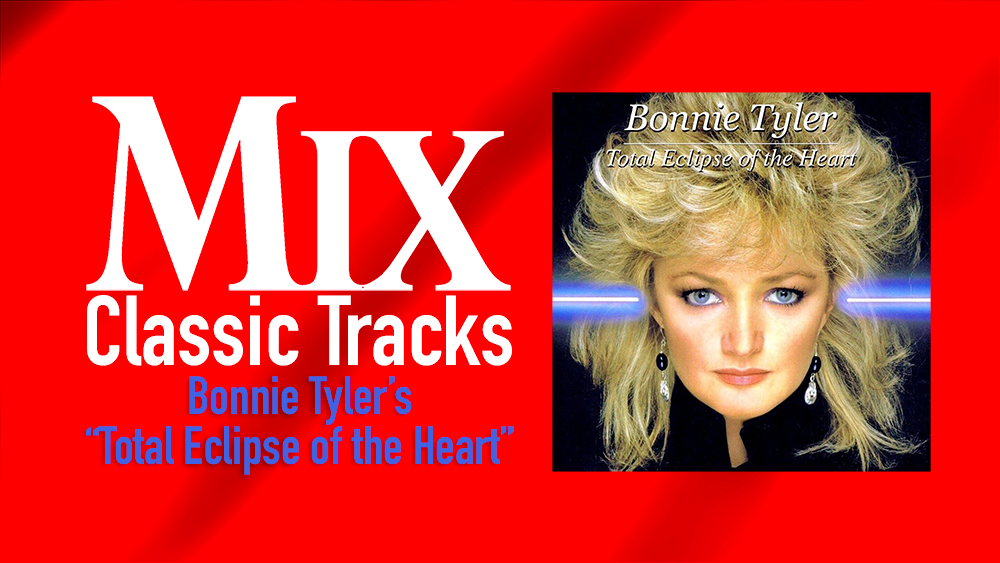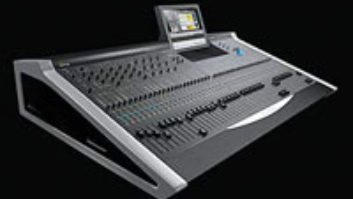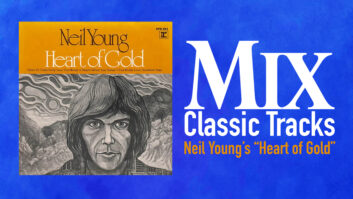
Neil Dorfsman laughs as he declares Bonnie Tyler’s “Total Eclipse of the Heart” an example of all the excesses of ’80s audio.
During the mix in studio B of New York City’s Power Station, he joked, they had run out of reverb. Looking at the board, every reverb send on every fader was as far up as it could go—on everything but the kick drum and bass guitar.
And while initially it seemed funny, the team—engineers Dorfsman and John Jansen, along with producer Jim Steinman—stopped laughing about 12 hours into the mix when they realized it was no joke. This was serious.
After all, this was a Jim Steinman production, where “production” meant two things—he was the producer and it was a “mega” production. Those who worked with him say he created his recordings like mini Broadway productions. (No surprise that Steinman ended up writing the musical Bat Out of Hell based on the Meat Loaf album.)
Dorfsman recalls Steinman wasn’t really that experienced at the time. He says he is grateful that Jansen was there to “talk Jim down from an idea like, ‘We need more canons in the bridge.’ ‘Jim, we can’t have any more cannons,’” Dorfsman recounts, adding they were created on the synth.
The track was cut live in studio A of Power Station with, as Dorfsman describes, Steinman’s “go-to” rhythm section at the time—Max Weinberg on drums, Roy Bittan on piano in the piano booth, Steve Buslowe on bass in the rhythm room—and Tyler singing live with Rory Dodd (singing the “turn around bright eyes” part) in separate iso booths. Dorfsman recalls that Rick Derringer’s guitar part and Larry Fast’s synthesizer parts were overdubs.
Two AKG 451s were miked close to what Dorfsman recalls as a “very bright” Yamaha piano. The mics on the drums were SM57s on the top and bottom of the snare, an AKG D12 and Neumann U47 fet on the kick drum, 421s on the tops and bottoms of the toms, AKG 451s on the hi-hat and overheads, and the room mics were U87s. Dorfsman believes he also set up a SM7 as a room mic.
“We didn’t have a whole lot of esoteric microphones. It was pretty basic,” he says. “Ambience recording wasn’t a fine art then like it’s become now. So it was pretty minimal.”
He says they probably ran about 20 takes of the track, which included the live lead vocals. Vocal mics would have probably been a U67 or Telefunken 251, Dorfsman says.
While some of the vocal recording is hazy in memory, what is clear is that the leads were at Power Station and Frank Filipetti, who calls this track a “vocal tour de force,” was in charge of recording at least the majority of the background vocals at Right Track Studios with Rory Dodd and Eric Troyer.
“As far as I’m concerned, Jim is one of the greatest songwriters and producers of our era,” Filipetti says. “Jim wasn’t as interested in adhering to traditional ways of doing things. He was always looking for something a little different. He was more interested in the emotional arc that the song was taking rather than going by the verse-chorus-verse-chorus-bridge formula. In doing so, his music took you on a journey.”
The way it translated in the audio recording, Filipetti says, was to determine the emotional center Steinman was trying to achieve; sifting through the multitude of takes to choose the right one.
At that time, he says he usually used a Neumann 269—the German version of the Neumann U67 with a Telefunken tube—and probably did because of Tyler’s voice and the others on the project. But he also liked using the AKG C12 on vocals as well.
Filipetti’s Right Track Studios studio B had an SSL4000 console and what he says were the standard LA2As and UREI 1176s. “I believe at that time we had a Massenburg EQ,” he says. “We probably had a couple of Pultecs, both the EQPs and the MEQs, but I also had my own limiter compressor at the time, which was a TubeTech 1A, which I still have. I used that for vocals all the time then, and of course back then everyone had two or three EMT plates. And we had a bathroom or two where we would occasionally throw vocals in and use as a chamber. They weren’t anywhere near the chambers at Capitol, but, hey, you did what you did and you certainly used all of your tools at hand. We didn’t have plug-ins, so if you wanted to do something, you found a way to do it.”
Filipetti says while the vocal sessions were difficult, the results were worth it. Explaining the arduous vocal stacking process, Filipetti says Eric and Rory would sing a vocal line for the chorus, perhaps a harmony part. Then they would double them doing the same line again.
“Then they would sing the next step in the harmonic sequence and they would probably do the tonic note first, then the third, then the fifth and we’d double each of those. Then we’d probably add an octave over the original and that would vary somewhat, but that was the basic idea,” Filipetti recalls, reminding that there was no Autotune back in those days. “Then we would go back and do the same thing again, but this time Eric and Rory would sing in harmony instead of in unison, and then when we did the double, they would switch the parts, so if Rory was on the top and Eric was on the bottom on the first pass, Rory would be on the bottom and Eric would be on the top on the second pass and we’d do the whole thing that way.”
“It was 2:00 am when we finished a 10-hour session doing the backgrounds,” recalls Dodd. “I thought we were done when Jim piped in, ‘Hey Icy [Dodd’s industry nickname, short for Ice Head, as he was Canadian], you want to sing the duet parts now?’ ‘I wanna go home Jim,’ but I acquiesced.”
Filipetti says these long days could have gone on for five to seven days! But the good news was there were no drugs on Steinman’s sessions and after about four or five hours, he ordered gobs of great Indian food and sushi.
“Jim really treated everyone first class, so it made all the hard work something you wanted to do,” Filipetti says.
Back at Power Station B, the 12-hour mix process occurred on the evening of July 4, 1982 as Dorfsman recalls taking a break to go out on the roof of the studio to watch the fireworks. He says they worked until about 2:00 or 3:00 a.m. and then returned the next day to address changes Steinman had.
“You can tell from the final mix that Jim wanted the biggest drum sound to ever have been recorded,” Dorfsman says. “In the ’80s there was a competition to see who could have the loudest snare drum.”
Dorfsman remarks that, as he prepared to speak about the track, he listened to the song on his computer and the snare didn’t sound as loud as he remembered, yet the kick drum sounded loud.
“Which was funny to me because Jim never personally liked the sound of the kick drum. He called it, ‘that horrible thumping noise,’ he recalls with a chuckle. “When I was in a restaurant about six months ago, I heard the song and the snare drum was incredibly loud, but for some reason on my computer it didn’t translate that way, but I remember the snare drum was huge with tons of reverb.”
Dorfsman says—laughing—rather than a race to the bottom, the mix was a race to the top, to get the snare drum louder than everything else, while competing with the kick drum and the vocals.
“I just remember all the faders just creeping, creeping, creeping, creeping…,” he says. “I discovered parallel compression on the drums at that point, so I would mult out the snare drum, and squash it with a UREI 1176. The hallmark of that record is the sound of reverb. I think that is the record where we had tried mixing it on the SSL in studio C, but Jim noticed we couldn’t get the same sound as the rough mix. That was really one of the first examples to me of trying to beat the rough, and we could never get some inexplicable sound, tone, vibe that we had gotten in the mix in studio A.
“We stopped mixing in studio C and waited until studio B was open, which still had a Neve 8068, and John Jansen and I mixed it manually. We just used as much reverb as we could humanly find. There was a live chamber at Power Station, which is an iconic sound—a multi-floor stairwell—which is all over that record as well as two or possibly three EMT plates, and I remember joking with Jim about halfway through the mix. He said it sounded dry and I said, ‘It sounds dry because there is so much reverb on everything that has become the new normal.’ I’m amazed that when you listen to it now you can actually hear discrete reverb on things.”
“Total Eclipse of the Heart” was No. 1 on Billboard’s Hot 100 for four weeks in 1983, while Steinman’s “Making Love Out of Nothing at All” hit No.2 simultaneously and remained there for three weeks, giving him a rare consecutive mega hit duo. “Total Eclipse of the Heart” has enjoyed resurgence in popularity during every solar eclipse as well.
“I remember very clearly the first time they ran ‘Total Eclipse of the Heart’ down, turning to Jim and saying, ‘This is going to be the biggest song you’ve ever recorded,’” Dorfsman says. “I knew it halfway through the recording. I thought it was quite brilliantly put together. I mean it’s super cartoonish with the explosions and synth solo; a very iconic Jim Steinman production—more is better; more of everything is better. But I just knew from the structure of it, and Bonnie was singing great on the live vocal—clearly she gave it her all. I just knew.
“And I was right.”






